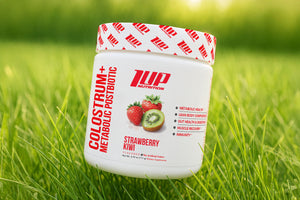Intermittent fasting is one of the most popular diets over the past few years.
It’s an umbrella term that encompasses a few different eating schedules, but essentially, intermittent fasting is an eating pattern that cycles between voluntary fasting and non-fasting over a given period of time.
Some of the most common intermittent fasting protocols are:
- 16:8 (16 hours fasting, 8 hours feasting)
- Alternate-day fasting
- Time-restricted feeding
Research also shows that intermittent fasting may be useful for losing weight, maintaining weight loss, supporting cardiometabolic health, and helping to stave off some forms of disease.[1,2,3]
In fact, some participants in our quarterly transformation challenges have used intermittent fasting to great success! (We should also mention that other winners have used other popular eating patterns like tracking macros and counting calories and gotten equally amazing results!)
As with everything in life, when something gains popularity, there are a number of misconceptions that accompany it.
Today, we discuss 5 misconceptions about intermittent fasting to help clear the air and shed some light on whether Intermittent fasting may be a beneficial tool to use during your own transformation challenge.
Top 5 Misconceptions About Intermittent Fasting
#1 Intermittent Fasting Causes Muscle Loss
Within the fitness community there is this paranoia that if you aren’t eating every 3 hours as well as chugging BCAAs or EAAs all day long, you’re going to lose muscle.
This simply isn’t true.
The body doesn’t discard adaptations it’s worked so hard to acquire (i.e. building muscle) quite that easily. Otherwise, every time you had a day where you were just a little low on protein or took a deload week in the gym, you’d lose all of your gains.
While fasting does deprive your body of food for a prolonged period of time, it doesn’t necessarily mean you’re going to lose muscle, especially if you’re still getting in enough protein during your feasting period.
Now, is intermittent fasting the most “optimal” way to eat if you’re looking to maximize muscle growth?
No.
But “optimizing” for muscle growth isn’t the same thing as retaining muscle tissue.
Intermittent fasting can be (and has been shown in research to be) effective for retaining muscle while dieting. Plus, some individuals find that they are less hungry throughout the day when restricting their eating window to only a certain few hours of the day.
The takeaway here is that provided you’re hitting your protein requirements each day during your feasting window, you don’t have to stress about muscle loss.
#2 You Can Eat Whatever You Want
As we just mentioned intermittent fasting can be a great tool to help people keep their calorie intake under control when dieting (or even if they’re trying to maintain their results).
That’s because the abbreviated eating window makes it harder to overeat.
Still, it’s not like intermittent fasting erases the need for you to be mindful of how many calories you’re eating each day.
After all, at the end of the day, calories reign supreme, and if you want to lose weight, you need to be in an energy deficit whereby you expend more calories than you consume.
For people with serious appetites, it’s entirely possible to overeat, even if you’re intermittent fasting.
Therefore, while you may not have to track your calories or macros as meticulously as you do if you’re following the IIFYM-style of dieting, you should at least be aware of portion sizes.
Additionally, just because you’re intermittent fasting doesn’t give you carte blanche to bing on ice cream, ding dongs, and fast food each day.
If you’re serious about getting results from intermittent fasting and your time spent in the gym, the majority of your food intake should be nutritious foods that are minimally processed -- fruits, vegetables, lean proteins, nuts, seeds, and whole grains.
#3 Fasting Slows Metabolism
Many individuals worry that fasting will slow their metabolism, making it that much harder to lose weight and get results during their transformation challenge.
There’s also the concern that because your metabolism “slowed” while fasting, that when you go back to eating, you’ll automatically gain fast since your body isn’t used to that much food.
As we said above, human physiology isn’t that delicate. Remember, our bodies have evolved over eons. Our ancestors were accustomed to going for hours (even days) without food. They didn’t have a drive-thru or takeout to hit up on the way home from work.
Furthermore, research in the American Journal of Clinical Nutrition (AJCN) found that individuals who practiced alternate-day fasting maintained a normal metabolic rate and burned more fat.[4]
The takeaway here is that as long as you’re hitting your calorie requirements each day, consuming adequate protein, and maintaining sufficient levels of physical activity throughout the day, you don’t have to worry about your metabolism grinding to a halt while practicing intermittent fasting.
For added help, you can always use a thermogenic weight loss support aid, such as Men’s and Women’s formulas Pro Ripped Max and Make Her Lean Max, which contain natural ingredients that support a healthy metabolism and enhance energy expenditure.
#4 Intermittent Fasting Impairs Athletic Performance
Growing up, you were probably told that you needed to “carb up” before any type of athletic endeavor. And, this has led many to believe that if they’re not pounding down a big bowl of rice or pasta before their training session, their performance will be subpar.
However, this simply isn’t the case for everyone.
Many individuals actually prefer to train fasted, and having any type of pre workout meal makes them feel bloated, sluggish, or heavy.
Now, if you’re someone who is used to eating before training, it may take a week or two to acclimate to training fasted.
Also, make sure to stay sufficiently hydrated during the day by consuming enough fluids and electrolytes.
One other thing to keep in mind, especially if you want to maximize muscle growth and minimize muscle loss, is to schedule your training session either during your feasting period, or have the workout end when your feasting period starts. This way, you mimizine the risk of muscle breakdown and can kick start the recovery and growth process as soon as your training session is over with your post workout whey protein shake.
#5 Intermittent Fasting is Unnatural and/or Unhealthy
In today’s era, it can seem out of place to think fasting is a good idea, especially when the narrative for many years was that you needed to eat breakfast first thing in the morning to “kickstart” your metabolism, and that if you weren’t eating every 3 hours, your metabolism would slow and you’d go catabolic.
However, this high frequency eating is really a modern convention, made all the worse with the plethora of readily accessible food options -- takeout, drive-thru, delivery services, etc.
For centuries, humans went for hours (sometimes even days) on end without a solid meal.
Remember, the human body is the most sophisticated machine ever created. It is incredibly flexible and can adapt to damn near everything thrown its way.
Going without food for several hours will shift the body to burning stored body fat and ketones for energy. And most of us, even ones that are reasonably in shape still have thousands of calories stored in our fat cells to get us through during those times when we opt to abstain from food.
And if you’re still concerned that intermittent fasting is “unhealthy”, research indicates that it may actually have an overall healing effect on the body by stimulating repair and protection mechanisms.[5]
Takeaway
At the end of the day, intermittent fasting is one of the many diets you can use to get results during your transformation challenge.
Is it some type of magic diet that allows you to eat whatever you want and not have to track calories?
No.
Is it the only way to diet to get results?
No.
It can be an effective means for controlling calorie intake for many individuals, but for others, they thrive and experience equally good weight loss results following a meal plan with more frequent feedings.
The only way to know if intermittent fasting is right for you is to give it a try, if you’re interested is experimenting. If not, that’s totally fine. Keep doing what you’re doing now, and if sometime in the coming months or years you decide to try intermittent fasting, use the tips above to assuage any concerns or fears you may have.
References
- Welton S, Minty R, O'Driscoll T, Willms H, Poirier D, Madden S, Kelly L. Intermittent fasting and weight loss: Systematic review. Can Fam Physician. 2020 Feb;66(2):117-125. PMID: 32060194; PMCID: PMC7021351.
- Harris L, Hamilton S, Azevedo LB, Olajide J, De Brún C, Waller G, Whittaker V, Sharp T, Lean M, Hankey C, Ells L. Intermittent fasting interventions for treatment of overweight and obesity in adults: a systematic review and meta-analysis. JBI Database System Rev Implement Rep. 2018 Feb;16(2):507-547. doi: 10.11124/JBISRIR-2016-003248. PMID: 29419624.
- De Cabo, R., & Mattson, M. P. (2019). Effects of Intermittent Fasting on Health, Aging, and Disease. New England Journal of Medicine, 381(26), 2541–2551.doi:10.1056/nejmra1905136
- Leonie K Heilbronn, Steven R Smith, Corby K Martin, Stephen D Anton, Eric Ravussin, Alternate-day fasting in nonobese subjects: effects on body weight, body composition, and energy metabolism, The American Journal of Clinical Nutrition, Volume 81, Issue 1, January 2005, Pages 69–73, https://doi.org/10.1093/ajcn/81.1.69
- Mattson, M. P., Longo, V. D., & Harvie, M. (2017). Impact of intermittent fasting on health and disease processes. Ageing Research Reviews, 39, 46–58. https://doi.org/https://doi.org/10.1016/j.arr.2016.10.005






